A physics walk through the Liseberg amusement park.
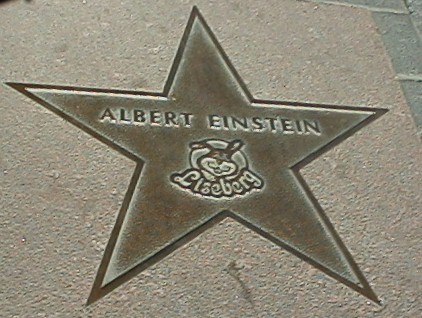 The path from Korsvägen to Liseberg includes a star with Albert Einstein's name. On July 11 1923 he gave his Nobel lecture - at Liseberg. It was the year when Liseberg opened in connection with World exhibit, hosted in Göteborg. At the time, the round building of Lisebergsteatern was a planetarium.
The path from Korsvägen to Liseberg includes a star with Albert Einstein's name. On July 11 1923 he gave his Nobel lecture - at Liseberg. It was the year when Liseberg opened in connection with World exhibit, hosted in Göteborg. At the time, the round building of Lisebergsteatern was a planetarium.
I think that Einstein would have loved the free fall drop towers, Uppskjutet (Space Shot) and AtmosFear, where you experience 2-3 seconds of weightlessness. The loading area for AtmosFear shows many timely physics terms - including the Higgs boson!
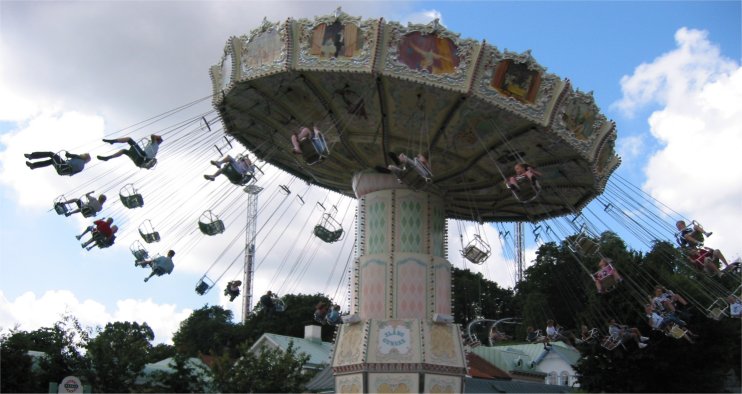 The equivalence between inertial and gravitational mass is also beautifully illustrated by the WaveSwinger ride. Take the stairs or escalator down from Uppskjutet in the upper park to reach
"Slänggungan".
If you are lucky, it starts half-loaded: Note how the angle to the vertical does not depend on whether the swing is empty or loaded. The equivalence principle in front of you eyes! And you might like to recall Eötvös who used the spinning earth as a giant carousel to test the equivalence principle.
The equivalence between inertial and gravitational mass is also beautifully illustrated by the WaveSwinger ride. Take the stairs or escalator down from Uppskjutet in the upper park to reach
"Slänggungan".
If you are lucky, it starts half-loaded: Note how the angle to the vertical does not depend on whether the swing is empty or loaded. The equivalence principle in front of you eyes! And you might like to recall Eötvös who used the spinning earth as a giant carousel to test the equivalence principle.
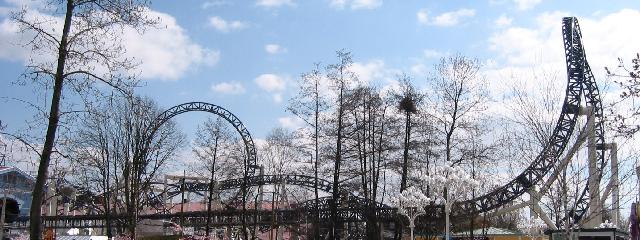 Continue past Slänggungan to reach the launched roller coaster Kanonen ("the Cannon").
Roller coasters are classical examples of energy conversions, with an interplay of kinetic and potential energy as the train moves around the curves, loops, hills and valleys of the track. In Kanonen, the traditional lifthill is replaced by a hydraulic launch, giving the train sufficient kinetic energy to move over the first hill. The energy needed for the Cannon train to reach the top is stored before launch by compressing nitrogen to 300 times normal atmospheric pressure. During launch, the gas expands, forcing the hydraulic oil to reach the winch that catapults train and riders out of the station with sufficient speed to reach the top of the first hill. With this technique, high speed can be reached faster and in shorter time - an obvious choice for a park embedded in a city.
Continue past Slänggungan to reach the launched roller coaster Kanonen ("the Cannon").
Roller coasters are classical examples of energy conversions, with an interplay of kinetic and potential energy as the train moves around the curves, loops, hills and valleys of the track. In Kanonen, the traditional lifthill is replaced by a hydraulic launch, giving the train sufficient kinetic energy to move over the first hill. The energy needed for the Cannon train to reach the top is stored before launch by compressing nitrogen to 300 times normal atmospheric pressure. During launch, the gas expands, forcing the hydraulic oil to reach the winch that catapults train and riders out of the station with sufficient speed to reach the top of the first hill. With this technique, high speed can be reached faster and in shorter time - an obvious choice for a park embedded in a city.
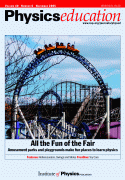 The shape of the loop, referred to as a clothoid, was introduced by
Werner Stengel in 1975. While the upper part is a circular arc, the lower part has a completely different shape. It is part of a "Euler spiral" or "Cornu spiral", where the radius of curvature increases as you get closer to the ground. Why? In a circular loop, you would be exposed to 6g more than at the top. Further, during the entry to a circular loop, the sudden increase of forces on the body, as well as sudden rotation, could lead to whiplash injuries. The clothoid shape leads to a slower onset and lower forces on the body.
The shape of the loop, referred to as a clothoid, was introduced by
Werner Stengel in 1975. While the upper part is a circular arc, the lower part has a completely different shape. It is part of a "Euler spiral" or "Cornu spiral", where the radius of curvature increases as you get closer to the ground. Why? In a circular loop, you would be exposed to 6g more than at the top. Further, during the entry to a circular loop, the sudden increase of forces on the body, as well as sudden rotation, could lead to whiplash injuries. The clothoid shape leads to a slower onset and lower forces on the body.
On the way back through the loop, the track runs around the "heartline" of the rider, rather than the rider travelling around the track. The rider moves with nearly constant velocity. The net force on the body is thus zero, with the force of gravity balanced by an opposing force from the train, although the direction of these forces in relation to the body changes during the motion. An unusual version of "uniform rectilinear motion".
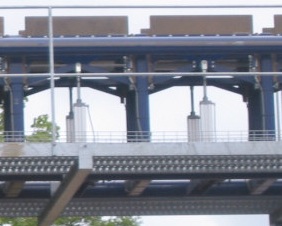 At the end of the ride, magnets on the train induce eddy currents in the braking fins, giving a smooth increase of the braking force as the remaining kinetic energy is absorbed by the brakes and converted to heat. Similar braking fins are mounted at the beginning of the track and are taken down just before the launch, and then raised again - can you figure out why?
At the end of the ride, magnets on the train induce eddy currents in the braking fins, giving a smooth increase of the braking force as the remaining kinetic energy is absorbed by the brakes and converted to heat. Similar braking fins are mounted at the beginning of the track and are taken down just before the launch, and then raised again - can you figure out why?
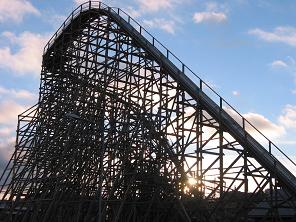 The wooden coaster, Balder, just beyond Kanonen was voted the best wooden coaster in the world during its opening year 2003 and also in 2005. The smooth ride is made possible by prefabricated glue laminated track elements. The strongest impression of the Balder ride - after experiencing 4g in the first valley - is probably the sense of lightness, as if gravity were somehow cancelled. It feels like it is very often "up" and more seldom "down". Contributing to this impression are several periods of floating air time, where the track has a built-in "parabolic flight", again letting the rider experience near weightlessness for a couple of seconds. Another feature contributing to the light feeling is that track has relatively few turns. The train runs like a shuttle in a loom, back and forth, and before most turns, the train moves up, limiting the speed, and thereby the g-forces in the turn.
Liseberg's position close to the center of Göteborg means that Balder has neighbours, who don't always appreciate happy roller coaster rider screams throughout the long summer evenings. Thus, in early 2004 a number of tunnels were added for damping the sound.
The wooden coaster, Balder, just beyond Kanonen was voted the best wooden coaster in the world during its opening year 2003 and also in 2005. The smooth ride is made possible by prefabricated glue laminated track elements. The strongest impression of the Balder ride - after experiencing 4g in the first valley - is probably the sense of lightness, as if gravity were somehow cancelled. It feels like it is very often "up" and more seldom "down". Contributing to this impression are several periods of floating air time, where the track has a built-in "parabolic flight", again letting the rider experience near weightlessness for a couple of seconds. Another feature contributing to the light feeling is that track has relatively few turns. The train runs like a shuttle in a loom, back and forth, and before most turns, the train moves up, limiting the speed, and thereby the g-forces in the turn.
Liseberg's position close to the center of Göteborg means that Balder has neighbours, who don't always appreciate happy roller coaster rider screams throughout the long summer evenings. Thus, in early 2004 a number of tunnels were added for damping the sound.
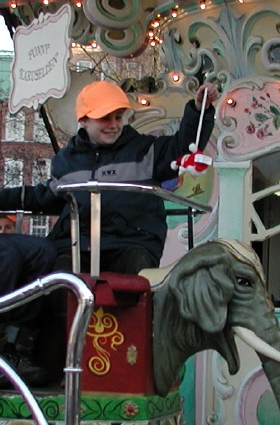 As you head north from Balder and then cross a bridge to the other side of
the river, a classical merry-go-round, Ponnykarusellen, with horses and
elephants.
The motion is slow enough that a miniature Foucault pendulum experiment
can be fun.
As you head north from Balder and then cross a bridge to the other side of
the river, a classical merry-go-round, Ponnykarusellen, with horses and
elephants.
The motion is slow enough that a miniature Foucault pendulum experiment
can be fun.
Continue north to Kaninlandet and the coffee table ride "Kaffekoppen"
(themed as a large coffee grinder). This ride combines a clockwise motion of the table with a faster
counter-clockwise motion of the three trays (and also the cups can be
turned by the passengers). The combined motion for someone on the ride
depends on the ratio between the angular velocities for the rotations,
which varies between different versions of the attraction (a nice
introductory programming exercise!). In Liseberg's case, the rider
follows a starshaped motion.
Amusement parks abound with real-life implementation of classical
textbook experiments and the fun is PHYSICS.
Read more at
physics.gu.se/LISEBERG and
tivoli.fysik.org

For ECSITE, 7 June 2013
Ann-Marie.Pendrill@fysik.lu.se
The Swedish National Resource Centre
for Physics Education
|
 The equivalence between inertial and gravitational mass is also beautifully illustrated by the WaveSwinger ride. Take the stairs or escalator down from Uppskjutet in the upper park to reach
"Slänggungan".
If you are lucky, it starts half-loaded: Note how the angle to the vertical does not depend on whether the swing is empty or loaded. The equivalence principle in front of you eyes! And you might like to recall Eötvös who used the spinning earth as a giant carousel to test the equivalence principle.
The equivalence between inertial and gravitational mass is also beautifully illustrated by the WaveSwinger ride. Take the stairs or escalator down from Uppskjutet in the upper park to reach
"Slänggungan".
If you are lucky, it starts half-loaded: Note how the angle to the vertical does not depend on whether the swing is empty or loaded. The equivalence principle in front of you eyes! And you might like to recall Eötvös who used the spinning earth as a giant carousel to test the equivalence principle.
 The path from Korsvägen to Liseberg includes a star with Albert Einstein's name. On July 11 1923 he gave his Nobel lecture - at Liseberg. It was the year when Liseberg opened in connection with World exhibit, hosted in Göteborg. At the time, the round building of Lisebergsteatern was a planetarium.
The path from Korsvägen to Liseberg includes a star with Albert Einstein's name. On July 11 1923 he gave his Nobel lecture - at Liseberg. It was the year when Liseberg opened in connection with World exhibit, hosted in Göteborg. At the time, the round building of Lisebergsteatern was a planetarium.  Continue past Slänggungan to reach the launched roller coaster Kanonen ("the Cannon").
Roller coasters are classical examples of energy conversions, with an interplay of kinetic and potential energy as the train moves around the curves, loops, hills and valleys of the track. In Kanonen, the traditional lifthill is replaced by a hydraulic launch, giving the train sufficient kinetic energy to move over the first hill. The energy needed for the Cannon train to reach the top is stored before launch by compressing nitrogen to 300 times normal atmospheric pressure. During launch, the gas expands, forcing the hydraulic oil to reach the winch that catapults train and riders out of the station with sufficient speed to reach the top of the first hill. With this technique, high speed can be reached faster and in shorter time - an obvious choice for a park embedded in a city.
Continue past Slänggungan to reach the launched roller coaster Kanonen ("the Cannon").
Roller coasters are classical examples of energy conversions, with an interplay of kinetic and potential energy as the train moves around the curves, loops, hills and valleys of the track. In Kanonen, the traditional lifthill is replaced by a hydraulic launch, giving the train sufficient kinetic energy to move over the first hill. The energy needed for the Cannon train to reach the top is stored before launch by compressing nitrogen to 300 times normal atmospheric pressure. During launch, the gas expands, forcing the hydraulic oil to reach the winch that catapults train and riders out of the station with sufficient speed to reach the top of the first hill. With this technique, high speed can be reached faster and in shorter time - an obvious choice for a park embedded in a city.  The shape of the loop, referred to as a clothoid, was introduced by
The shape of the loop, referred to as a clothoid, was introduced by
 At the end of the ride, magnets on the train induce eddy currents in the braking fins, giving a smooth increase of the braking force as the remaining kinetic energy is absorbed by the brakes and converted to heat. Similar braking fins are mounted at the beginning of the track and are taken down just before the launch, and then raised again - can you figure out why?
At the end of the ride, magnets on the train induce eddy currents in the braking fins, giving a smooth increase of the braking force as the remaining kinetic energy is absorbed by the brakes and converted to heat. Similar braking fins are mounted at the beginning of the track and are taken down just before the launch, and then raised again - can you figure out why?
 The wooden coaster, Balder, just beyond Kanonen was voted the best wooden coaster in the world during its opening year 2003 and also in 2005. The smooth ride is made possible by prefabricated glue laminated track elements. The strongest impression of the Balder ride - after experiencing 4g in the first valley - is probably the sense of lightness, as if gravity were somehow cancelled. It feels like it is very often "up" and more seldom "down". Contributing to this impression are several periods of floating air time, where the track has a built-in "parabolic flight", again letting the rider experience near weightlessness for a couple of seconds. Another feature contributing to the light feeling is that track has relatively few turns. The train runs like a shuttle in a loom, back and forth, and before most turns, the train moves up, limiting the speed, and thereby the g-forces in the turn.
Liseberg's position close to the center of Göteborg means that Balder has neighbours, who don't always appreciate happy roller coaster rider screams throughout the long summer evenings. Thus, in early 2004 a number of tunnels were added for damping the sound.
The wooden coaster, Balder, just beyond Kanonen was voted the best wooden coaster in the world during its opening year 2003 and also in 2005. The smooth ride is made possible by prefabricated glue laminated track elements. The strongest impression of the Balder ride - after experiencing 4g in the first valley - is probably the sense of lightness, as if gravity were somehow cancelled. It feels like it is very often "up" and more seldom "down". Contributing to this impression are several periods of floating air time, where the track has a built-in "parabolic flight", again letting the rider experience near weightlessness for a couple of seconds. Another feature contributing to the light feeling is that track has relatively few turns. The train runs like a shuttle in a loom, back and forth, and before most turns, the train moves up, limiting the speed, and thereby the g-forces in the turn.
Liseberg's position close to the center of Göteborg means that Balder has neighbours, who don't always appreciate happy roller coaster rider screams throughout the long summer evenings. Thus, in early 2004 a number of tunnels were added for damping the sound.
 As you head north from Balder and then cross a bridge to the other side of
the river, a classical merry-go-round, Ponnykarusellen, with horses and
elephants.
The motion is slow enough that a miniature Foucault pendulum experiment
can be fun.
As you head north from Balder and then cross a bridge to the other side of
the river, a classical merry-go-round, Ponnykarusellen, with horses and
elephants.
The motion is slow enough that a miniature Foucault pendulum experiment
can be fun.
